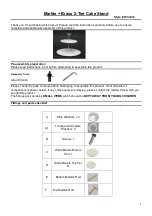
EN
-
30
9 Disposal
MB EVO PRO/MB EVO
8.2
Selecting and attaching the wire guide
1
Select the welding materials appropriate for the welding task at hand.
2
Attach the wire guide appropriate for the welding materials you are
using.
Steel: Shortening and mounting the spiral liner, fig. E
Stainless steel, aluminum, copper, nickel: Mounting and shortening the PA
liners, fig. D
8.2.1
Shortening and mounting the spiral liner, fig. E
1
Lay out the cable assembly straight.
2
At the torch neck: remove wear parts.
3
At the central plug: unscrew the nut.
4
At the central plug: remove the spiral liner, replace it with a new one and
insert it into the wire conduit as far as it will go.
5
At the central plug: manually tighten the nut.
6
At the torch neck: use a cutter to cut off excess spiral liner so it is flush with
the outlet opening.
7
At the central plug: unscrew the nut.
8
Remove the spiral liner again.
9
Deburr and grind down the edge at the spiral liner (angle approx 40°).
10
At the central plug: insert the spiral liner in the wire conduit again as far
as it will go.
11
At the central plug: manually tighten the nut.
12
At the torch neck: mount the wear parts.
4.3 Connecting the cable assembly, fig. A on page EN
8.2.2
Mounting and shortening the PA liners, fig. D
1
Lay out the cable assembly straight.
2
Sharpen the PA liner with the
ABICOR BINZEL
sharpener (angle
approx. 40°).
3
At the central plug: unscrew the nut. Remove the PA liners, replace it with
a new one and insert it into the wire conduit as far as it will go.
4
At the central plug: slide the trunnion and O-ring on the PA liner.
5
At the central plug: manually tighten the nut.
6
The PA liner must end just before the wire feeder's conveyor rollers.
Calculate the maximum excess and mark it on the PA liner.
7
Use the
ABICOR BINZEL
cutter to cut off the PA liner at the marking and
deburr the edge.
4.3 Connecting the cable assembly, fig. A on page EN
8.3
Cleaning the cable assembly
1
Replace any damaged, deformed or worn parts.
2
Lay out the cable assembly straight.
3
At the central plug: Unscrew the nut.
4
Clean the wire conduit from both sides with compressed air.
4.3 Connecting the cable assembly, fig. A on page EN
9 Disposal
10 Warranty
This product is an original
ABICOR BINZEL
product.
Alexander BINZEL
Schweisstechnik GmbH & Co. KG guarantees that the product has been
manuafactured without defects and offers factory manufacturing and
functional warranty for this procduct upon delivery in line with current state-
of-the-art technology and the current regulations. To the extent that
ABICOR
BINZEL
is responsible for a deficiency in the product,
ABICOR BINZEL
shall be obliged to choose, at its own discretion, to either repair the defect or
deliver a replacement at its own expense. The warranty covers manufacturing
faults, but not damage resulting from natural wear and tear, overloading or
improper use. The warranty period is defined in the General Terms and
Conditions. Exceptions in the case of specific products are regulated
separately. Warranty will also be rendered invalid if spare parts and wearing
parts are used that are not original
ABICOR BINZEL
parts and if the
product has been repaired improperly by the user or a third party. Wearing
parts are excluded in general from the warranty. In addition,
ABICOR
BINZEL
is not liable for damage caused by using our products. Questions
about warranty and service can be addressed to the manufacturer or our
distributors. For more information, visit
NOTICE
• The order data and ID numbers for the equipment parts and wear parts can be found in the current
ABICOR BINZEL
replacement and wear parts price
www.binzel-abicor.com.
• Use only original
ABICOR BINZEL
wear parts.
• Use the
ABICOR BINZEL
wrench to assemble and disassemble and ensure that wear parts specific to the welding torch are correctly assigned.
NOTICE
• For PA liners with an outer diameter of 4.0 mm, the capillary tube in the adaptor connection must be replaced by a guide tube.
WARNING
Risk of injury
Serious injuries may be caused by parts swirling around.
• When cleaning the wire guide with air, wear suitable protective clothing, in particular safety goggles.
Equipment marked with this symbol is covered by European Directive 2012/19/EU on waste electrical and
electronic equipment (WEEE).
• Electrical and electronic equipment must not be disposed of with household waste.
• Electrical and electronic equipment must be collected separately and recycled in an environmentally friendly
manner.
• Please observe the local regulations, laws, provisions, standards and guidelines.
• Your local authority can provide you with information about the collection and return of electrical and
electronic equipment.
• To dispose of the product correctly, it must first be disassembled.
















































